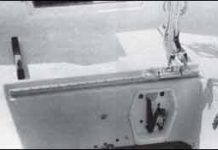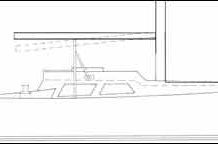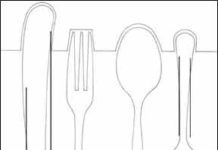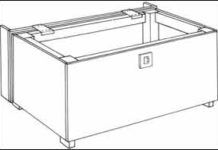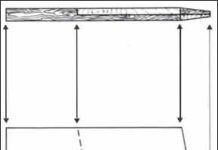Design For: Cockpit Foot Brace
Modern yachts are frequently advertised as having spacious cockpits: and, indeed, they do. But it doesn't take many afternoons of sailing to discover that the cockpit which seemed so splendidly roomy in the showroom or at the boatyard is too damned wide: it's impossible to brace your legs across the footwell without sliding down so that your body only contacts the boat at shoulders and tailbone. If you want to sit on the cockpit coaming while steering there's no place at all to brace your feet.
Taming the Wild Boom: Two Designs for a Gallows
A wildly flailing boom is one of the most dangerous objects aboard a sailboat. If you could completely control the boom at anchor and under power, and while raising, lowering, and reefing the sail you'd avoid worry, save energy and be much safer. For this reason, many serious cruising boats have traditionally carried permanent boom gallows. They usually take the form of metal pillars bridg ed across the top by a wooden cross member. Bolted to the deck at the aft end of the cockpit or on the aft deck itself, they serve several functions: holding the boom firmly when the sail is down; catching the boom easily as the sail is lowered; and, perhaps most importantly, keeping the boom steady during reefing operations.
Design For: Tableware Storage
One solution to the problem of tableware stowage is a bulkhead rack of the type commonly available from marine chandleries and discount houses. If you have some free bulkhead space in the galley area such racks can be fine, but, if you've got a drawer or cupboard available, stowing your tableware under cover seems a better solution. The problem is that the tableware should be secured within the drawer or cupboard. You could use one of the compartmented, plastic trays such as many of us employ at home, but ideally you want something which holds the tableware against the movement and vibration of the boat.
Design For: A Dock Box
Whether by choice or force of circumstance, increasing numbers of us are sailing out of marina slips rather than off moorings. For anyone using a slip or dock as home base, a dock box is a handy receptacle for spare lines, fenders, paint, varnish, tools, and miscellaneous gear. Also, a solid dock box can make a useful, if low, work bench, and sometimes serves as a step for a boat with high topsides. The smallest, lowest priced, commercially available dock boxes sell at discount for nearly $200, and the cost can go up to over $300. Hence, making a box yourself can save you a good deal of money. The illustration shows the construction of a basic, plywood-skinned box with notes on material sizes or scan't- flings. As you can see, construction is simple enough so that even a beginner can make a good job of it.
Design For: Stern Rail Mount Work Surface
For those who enjoy fishing or charcoal cooking, here's a design for a stern rail mount work surface useful for fish cleaning and meat cutting, and big enough to hold a hibachi when moored. I got the idea from yacht designer C.W. "Chuck" Paine, and Chuck got the idea from some Caribbean charter boats. You could also clamp a vise to the work surface and thus have a handy little work bench for onboard repairs and modifications. Mounted as it is on the stern rail, it is at a useful height, and offal and mess are easily cleared overboard. A hibachi used on the surface demands careful use, of course — as with any open flame on a boat — but it's about as far outboard a position as can be found. It's also a lot cheaper than those charcoal grills designed to be clamped to the stern rail.
It Takes a Tough Sailor to Make a Smooth Boat Bottom
Fairing in through hull fittings, as described in the February issue, will go a long way toward reducing bottom drag in light air, but it won't really do the job unless the paint surface of the bottom is smooth. A surprisingly high percentage of boats not used primarily for racing have bottom paint jobs that range from poor to atrocious. If your bottom has peeling patches that haven't been in, brush marks from failure to smooth out thick bottom paints, or stipple marks from application with a roller, your boat will be slower in light air than it could be. Bottom paints, unlike topside paints, are not formulated for smooth application, in most cases. They have a high solids content and quick-flashing solvents, a combination guaranteed to make smooth application difficult. Even the racing boat with the smoothest bottom didn't start out that way.
Teak: A Little Effort Goes a Long Way
Probably nothing can make or break the appearance of a fiberglass boat more quickly than the appearance of the exterior teak trim. Contrary to popular belief, teak is not a maintenance-free wood that can be safely ignored and neglected for years at a time. Though teak may not rot, it can check, warp, and look depressingly drab if not properly cared for. Although it is not immune to neglect, teak is incredibly resilient, and can be brought back to life after remarkable amounts of abuse. Therefore, there is no excuse for drab, ugly exterior teak on any boat. Unlike other woods used for exterior trim, the grey weathering of teak rarely extends very far below the surface of the wood.
A Homemade Tiller Tender
On my Catalina 22 I have a tiller tender which has served me well for many years — and it didn't cost a cent. On top of the tiller are two pieces of 3/8" x 3/4" hardwood about 5" long. The two pieces are drilled horizontally, at the joint line, about 2" from the end to accommodate a 3" length of split neoprene which has an inside diameter slightly less than the diameter of the braided line which runs to the coamings. Two holes drilled vertically near the ends are used to fasten the device to the tiller.
Lay New Nonskid to Restore Worn Decks
We don't really know what the life expectancy of a fiberglass boat may be. There are lots of them out there that are more than 20 years old, still going strong. We do know, however, that no matter how longlived fiberglass may be as a structural material, over time the gelcoat surface commonly used in finishing fiberglass becomes porous and chalky, and has the unfortunate tendency to crack and craze. Gelcoat, in other words, weathers just as a painted surface will over time. With topsides, a tired gelcoat surface can be restored to better than new condition through the use of polyurethane paints, which can retain color and gloss for years. Decks, however, are another story.
Adjust Your Own Compass
With a little care, boatowners can do a perfectly adequate job of compensating their own compasses. The objective in compass adjusting is to neutralize the boat's magnetism, not to make the compass point in any particular direction. You can determine the effect of the boat's magnetic field on any compass bearing by simply turning the boat 180 for the amount that the compass overshoots or under‑shoots a 180' change is always just twice the effect of the boat's field on that heading.





































